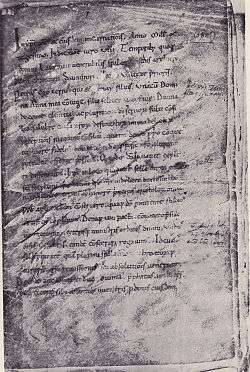Supetar Cartulary
Supetar cartulary or Sumpetar cartulary (Croatian: Supetarski kartular) is a 12th-century cartulary which contains charters from the years 1080 to 1187.[1]
| Supetar Cartulary | |
|---|---|
| Sumpetar Cartulary Cartulary of St. Peter in Poljice Jura sancti Petri de Gomai | |
 First page of the Supetar Cartulary | |
| Language | medieval Latin |
| Date | varies, 1105 - 14th century (mostly 12th century) |
| Provenance | Monastery of St. Peter in Poljice (ruins) |
| Authenticity | The main part is generally accepted as authentic, with later additions as spurious |
| First printed edition | 1844 by Frano Carrara |
| Genre | Cartulary |
| Length | 30 leaves total |
| Subject | Charters of monastery of St. Peter in Poljice, Croatia |
| Period covered | 11th and 12th century |
| Personages | Demetrius Zvonimir of Croatia, Lawrence, Archbishop of Split, Petar Crni |
Although the cartulary itself just lists the possessions of the monastery of St. Peter in Poljice, Croatia and the ways through which they were acquired˙(such as purchase or grants), it also contains a few important historical notes. It is preserved in its original form. In its basis, the cartulary is actually a chronicle of the Benedictine monastery which was founded around 1080 by a Croatian dignitary and slave owner Petar Crni (Peter the Black).[2]
Today, it is kept in the treasury of the Cathedral of Saint Domnius in Split.
Description
The cartulary traces the foundation of the monastery of Saint Peter in Poljice, near Split on October 11, 1080, during the reign of king Demetrius Zvonimir. It was founded by a local nobleman Petar Crni, son of Gumaj, and his wife Mary. The document represents an important insight into the social and economic situation and circumstances in 11th-century Croatia and Dalmatia. It chronologically lists land exchanges, and more importantly, the acquisition of slaves, which had been a profitable trade in the region.[3]
It contains rich onomastics material. Apart from personal names of Slavic, Roman and Christian origin, it also contains vernacular nicknames such as Platichlebi (plati + hleb, "buy bread"), Tilstacossa (Tusta kosa, thick hair), Urascana (Vraškonja) and so on.[4]
The cartulary also contains information on the political situation in late 11th century Croatia, naming the feudal families from which bans (viceroys) were elected from and others which were eligible for being elected as župans and states that in the case that the reigning king of Croatia dies without an heir a new king is elected by the bans, giving primacy to the bans of Croatia, Slavonia and Bosnia.
References
- Zelić-Bučan, Benedikta, Članci i rasprave iz starije hrvatske povijesti, str. 186
- Stipišić, Jakov, Pomoćne povijesne znanosti, Zagreb 1972, str. 165.
- Raukar, Tomislav, Hrvatsko srednjovjekovlje, Zagreb 1997, str. 198.
- Novak-Skok, p. 259.
Further reading
- Novak, Viktor i Petar Skok. Supetarski kartular. Zagreb: JAZU, 1952. Source